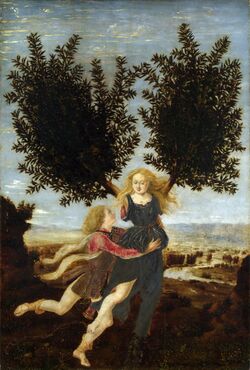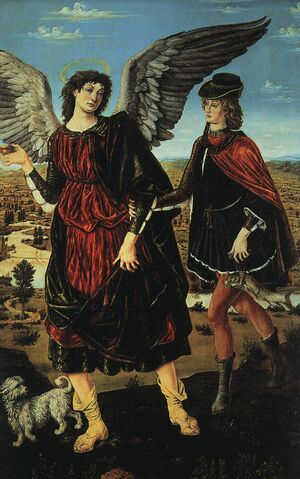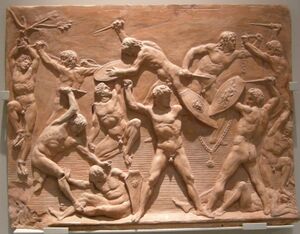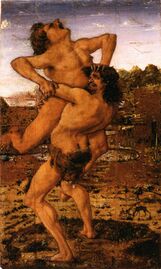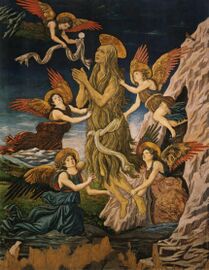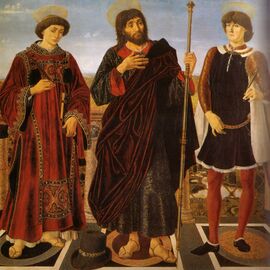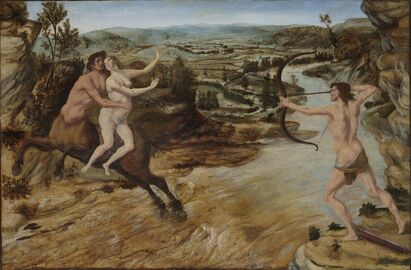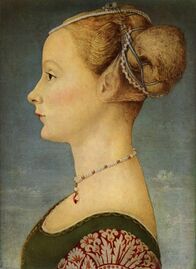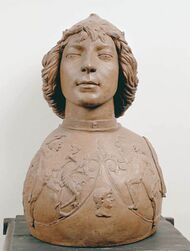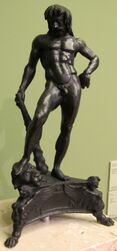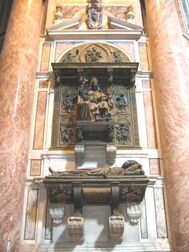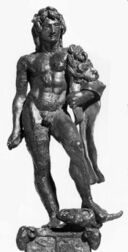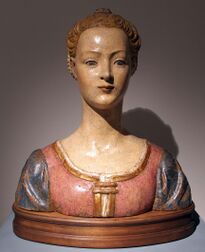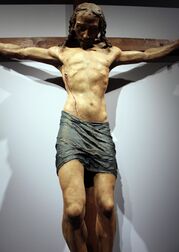أنطونيو پولايولو
أنطونيو دل پولايولو | |
|---|---|
Antonio del Pollaiolo | |
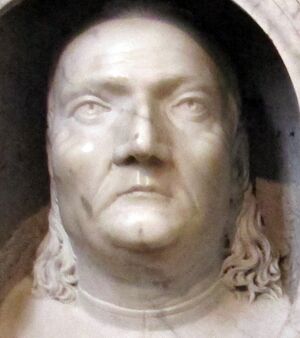 أنطونيو دل پولايولو، تفصيلة من قبره | |
| وُلِدَ | . ح. 17 يناير 1429 |
| توفي | 4 فبراير 1498 |
| عـُرِف بـ | نحات، صائغ |
العمل البارز | معركة العراة |
أنطونيو دل پولايولو ( Antonio del Pollaiolo ؛ UK: /ˌpɒlaɪˈwoʊloʊ/ POL-eye-WOH-loh,[1] US: /ˌpoʊl-/ POHL-,[2] النطق بالإيطالية: [anˈtɔːnjo del pollaˈjwɔːlo] ؛ عاش 7 يناير 1429/1433 - 4 فبراير 1498) ويعرف أيضاً باسم أنطونيو دي جاكوپو پولايولو أو أنطونيو پولايولو، كان رسام، نحات، نقاش وصائغ إيطالي، صنع أعمالاً مهمة في كل تلك الصيغ، كما صمم أعمالاً في صيغ أخرى، مثل vestments, metal embroidery being a medium he worked in at the start of his career.
His most characteristic works in his main media show largely naked male figures in complicated poses of violent action, drawing from classical examples and often centred on a heroic Hercules. He, or possibly his brother, was also a innovative painter of wide landscape backgrounds, perhaps having learnt from Early Netherlandish painting.[3] His two papal tombs were the only monuments to survive the demolition of Old St Peter's in the next century and be reconstructed in the present St Peter's Basilica.[4]
He very often worked in collaboration with his younger brother Piero del Pollaiuolo (ح. 1443–1496), and distinguishing their contributions to satisfy modern ideas of authorship has proved exceptionally difficult, so that many paintings are just described as by the Pollaiuolo brothers.[5] Contemporaries, and Giorgio Vasari, saw Antonio as by far the more talented, and responsible for the design and main painting of most works,[6] but in recent decades the reputation of Piero has strengthened somewhat, and he is now given sole authorship of, for example, the small Apollo and Daphne (1470–1480) by its owner, the National Gallery.[7] At the same time, contemporary references in lists of leading artists, of which there are a number, mostly mention the brothers together,[8] and Vasari's Lives of the Artists treats them in a single life.
According to Kenneth Clark, two factors have reduced his prominence in the modern view of Quattrocento art: the loss of his very large paintings of some of the Labours of Hercules, and "a name which looks difficult to pronounce". In his own day, and for several decades later, his "true position" as "one of the originating forces in the history of European art" was recognised.[9]
إعادة توزيع اللوحات بين الشقيقين
In recent years there has been a trend among art historians to increase the credit Piero is given for the paintings, led by Aldo Galli, whose Antonio and Piero Del Pollaiuolo: Silver and Gold, Painting and Bronze (2014) assigns the actual painting of many works to Piero that had long been given to Antonio, or both brothers. Galli only attributes to Antonio the reduced versions of the two Labours of Hertcules (Uffizi), the Dancing Nudes fresco, and an early altarpiece with the Elevation of the Magdalen.[10] At least one of the brothers was influenced by the landscape style of Early Netherlandish painting, and the revisionist school thinks that this was Piero. Attributions of works of sculpture and other media are unaffected.
Vasari began the tradition of stressing the contribution of Antonio rather than Piero to the paintings, which went largely unchallenged until the 20th century,[11] despite suspicions by art historians such as Martin Davies, Director of the National Gallery.[12] In the 21st century a full and partly successful challenge has been mounted, and some attributions changed by owning museums. This article gives the traditional attributions, or follows the owning museums, sometimes noting changes in recent years.
حياته
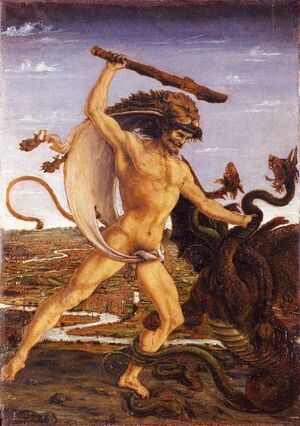
ولد في فلورنسا. وقد تعلم أنطونيو بولايولو عم سيمونى Simone (en) دقة التصميم ورقته حين كان صائغاً في مشغل والد ياقوبو. وقد رفعته منتجاته من الفضة والذهب إلى مكانة جعلته تشليني Cellini زمانه، والصديق المفضل للورنزو، وللكنائس، ومجلس السيادة في فلورنس، وطوائف الحرف. ولاحظ أنطونيو أن هذه التحف الصغيرة قلما تحتفظ باسم صانعها، وكان يتوق كما يتوق رجال النهضة إلى تخليد شهرته، فأتجه نحو النحت وصب من البرونز تمثالين فخمين لهرقل Hercules لا يقلان في قوتهما عن تمثال الأسرى لميكل أنجلو وعن تمثال لأوكؤون الذي رمز إلى العاطفة المعذبة. ولما انتقل بعدئذ إلى الرسم روى قصة هرقول في ثلاثة رسوم جدارية لقصر آل مديتشي، وتحدى بوتيتشلى في صورة أبولو ودافني وضارع سخف مائة من الفنانين بأن أظهر كيف يستطيع القديس سباستيان أن يتلقى وهو هادئ السهام التي يرميه بها الرماة من أقواسهم على مهل، فلا تؤثر في جسمه قط. وعاد أنطونيو في سنيه الأخيرة إلى صنع التماثيل، وصب لكنيسة القديس بطرس القديمة في رومة نصبين فخمين لقبري سكتس الثامن أظهر فيهما من قوة النت ودقة العلم بالتشريح ما يبشر مرة أخرى ببراعة ميكل أنجلو المقبلة.
أعماله الرئيسية
النقش
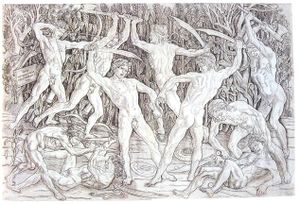
He only produced one surviving engraving, the Battle of the Nude Men, but both in its size and sophistication this took the Italian print to new levels, and remains one of the most famous prints of the Renaissance.[13] He produced a terracotta relief with a different composition of such a battle; both are mentioned by Vasari, who says he made other engravings, but may have been confused by copies or versions by others.[14]
أعمال أخرى
He designed a set of vestments for the Florence Baptistery in the 1460s, a prestigious commission, with the work being done by specialists.[15] He was still being paid for design work on these in 1480.[16]
His drawings are praised by 15th-century writers, and apparently collected and used as models by other artists. Later, Vasari says he owned some, including designs for an equestrian statue;[17] such a drawing survives in Berlin. Drawings now attributed to his own hand are fewer than they used to be; probably fewer than twenty. Some of these are figure studies, others narrative scenes, and there are two designs, on either side of the same sheet for church metalwork pieces that have not survived. This sheet is actually signed on both sides, it appears by Antonio himself, with "Antonio Pollaiuolo horafo".[18]
أعمال موقّعة ومؤرخة
Antonio neither signed nor dated his paintings; in contrast Piero signed one altarpiece. However, Antonio did include his inscribed name on both his papal tombs, as well as on his single engraving. In these works he was (as was typical at the period) keen to include his "nationality" as a citizen of the Republic of Florence, and sometimes to stress his other skills beyond sculpture.[19]
The engraving is signed: OPVS ANTONII POLLAIOLI FLORENTINI ("the work of Antonio Pollaiuolo the Florentine") on a tablet at left.[20] Signing a print so prominently was unusual at this period.[21] The main inscription on the tomb of Pope Sixtus IV is given above; there are two shorter ones in other parts of the monument: ANTONIUS POLLAIOLUS FLORENTINUS and OPUS ANTONII DE FLORENTIA.[22]
الأعمال الرئيسية
اللوحات
Cardinal of Portugal's Altarpiece, c. 1466, by Piero according to Galli
Hercules and Deianira (c. 1470)
Portrait of a Young Woman, Museo Poldi Pezzoli, Milan. Perhaps by Piero.
- The Assumption of St Mary Magdalene (c. 1460) – Tempera on panel, Museo della Pala del Pollaiolo, Staggia Senese
- Cardinal of Portugal's Altarpiece or Saints Vincent, James and Eustace (c. 1466) – Uffizi, copy in situ in San Miniato al Monte, Florence
- Portrait of a Young Woman (c. 1465) – Poplar panel, 52.5 × 36.2 cm, Staatliche Museen, Berlin
- Martyrdom of Saint Sebastian (1473–1475), with his brother, - Panel, 292 x 223 cm, National Gallery, London
- Portrait of a Young Woman (c. 1475) – Tempera on wood, 55 × 34 cm, Uffizi, Florence
- Hercules and the Hydra (c. 1475) – Tempera on wood, 17 × 12 cm, Uffizi, Florence
- Hercules and Antaeus (c. 1478) – Tempera on wood, 16 × 9 cm, Uffizi, Florence
- Portrait of a Young Woman – Panel, Museo Poldi Pezzoli, Milan
- Hercules and Deianira (c. 1470) – Oil on canvas, Yale University Art Gallery, New Haven
النحت
Parade shield with plaster Milo of Croton, Louvre
Tomb of Pope Innocent VIII, Pollaiuolo's second papal tomb
Detail of his cork crucifix, 1470s, San Lorenzo, Florence
- Hercules (1475) – Bode Museum, Berlin
- Tomb of Pope Sixtus IV (1493) – St. Peter's Basilica
الهامش
- ^ "Pollaiuolo". Lexico UK English Dictionary. Oxford University Press. Archived from the original on 22 March 2020.
- ^ "Pollaiuolo". Collins English Dictionary. HarperCollins. Archived from the original on 29 July 2019. Retrieved 29 July 2019.
- ^ Hartt, 316–317; Seymour, 179
- ^ Ettlinger, 239
- ^ Wright, 1–2; Seymour, 179
- ^ Vasari
- ^ Tempera on wood, 30 × 20 cm
- ^ Wright, 7–9
- ^ Clark, 181
- ^ Galli, 49-50
- ^ Galli, 36-43
- ^ Davies, 442–443, also 444 and 446 on the gallery's two Pollaiuolo paintings.
- ^ Hartt, 315
- ^ Vasari
- ^ Vasari
- ^ Wright, 14, 16
- ^ Vasari
- ^ Wright, 49–51
- ^ Wright, 1–2
- ^ "British Museum page". Archived from the original on 4 March 2023. Retrieved 6 May 2023.
- ^ Wright, 2
- ^ Wright, 530
المراجع
- Clark, Kenneth, The Nude, A Study in Ideal Form, orig. 1949, various edns, page refs from Pelican edn of 1960
- Davies, Martin, The Earlier Italian Schools, National Gallery Catalogues, 1961, reprinted 1986, ISBN 0901791296
- Ettlinger, L. D., “Pollaiuolo’s Tomb of Pope Sixtus IV”, Journal of the Warburg and Courtauld Institutes, vol. 16, no. 3/4, 1953, pp. 239–74, JSTOR
- Galli, Aldo, "The Fortune of the Pollaiuolo Brothers", in Antonio and Piero del Pollaiuolo: "Silver and Gold, Painting and Bronze”, exhibition catalogue (Milan, Museo Poldi Pezzoli, 2014 – 2015), eds. A. Di Lorenzo and A. Galli , Milan 2014, pp. 25–77, PDF on Academia.edu
- Hartt, Frederick, History of Italian Renaissance Art, (2nd edn.) 1987, Thames & Hudson (US Harry N Abrams), ISBN 0500235104
- Seymour, Charles Jr., Sculpture in Italy, 1400–1500, 1966, Penguin (Pelican History of Art)
- "Vasari": Giorgio Vasari's joint biography of the Pollaiuolo brothers, in his Lives of the Artists.
- Wright, Alison, The Pollaiuolo Brothers: The Arts of Florence and Rome, 2005, Yale, ISBN 9780300106251, google books
للاستزادة
- Ettlinger, L. D., Antonio and Piero Pollaiuolo, 1978, Phaidon, ISBN 0714817686
وصلات خارجية
- Leonardo da Vinci, Master Draftsman, exhibition catalogue fully online as PDF from the Metropolitan Museum of Art, which contains material on Antonio del Pollaiuolo (see index)
- The Gubbio Studiolo and its conservation, volumes 1 & 2, from The Metropolitan Museum of Art Libraries (fully available online as PDF), which contains material on Antonio del Pollaiuolo (see index)
- Short description is different from Wikidata
- Articles with hatnote templates targeting a nonexistent page
- Missing redirects
- مواليد القرن 15
- وفيات 1498
- أشخاص من فلورنسا
- رسامون إيطاليون
- رسامون توسكانيون
- نحاتون إيطاليون
- فنانو النهضة
- طباعون إيطاليون
- Burials at San Pietro in Vincoli
- صاغة إيطاليون
- Italian Renaissance painters
- Italian Renaissance sculptors
- Painters from Florence
- Sculptors from Florence
- Quattrocento painters
- 15th-century births
- 1498 deaths
- Italian goldsmiths
- Italian male sculptors
- Italian printmakers
- Italian Roman Catholics
- 15th-century people from the Republic of Florence
- 15th-century Italian painters
- 15th-century Italian sculptors
- 15th-century engravers
- Catholic painters
- Catholic decorative artists
- Catholic engravers
- Catholic sculptors
- Sibling artists
